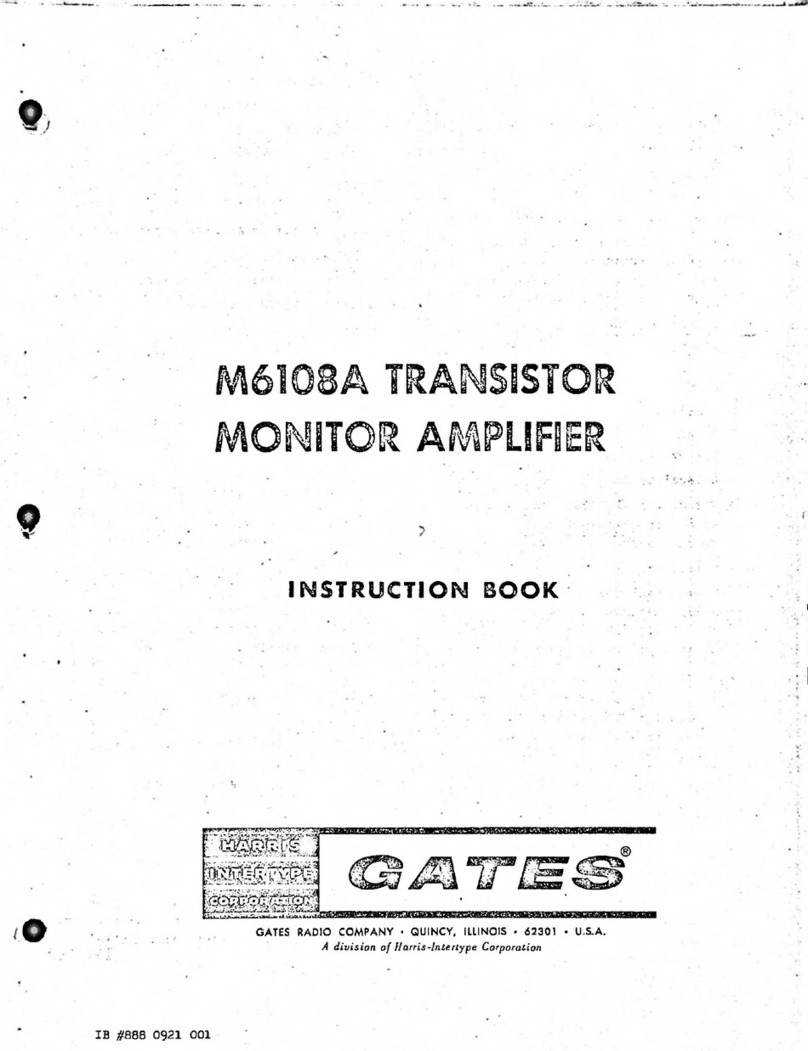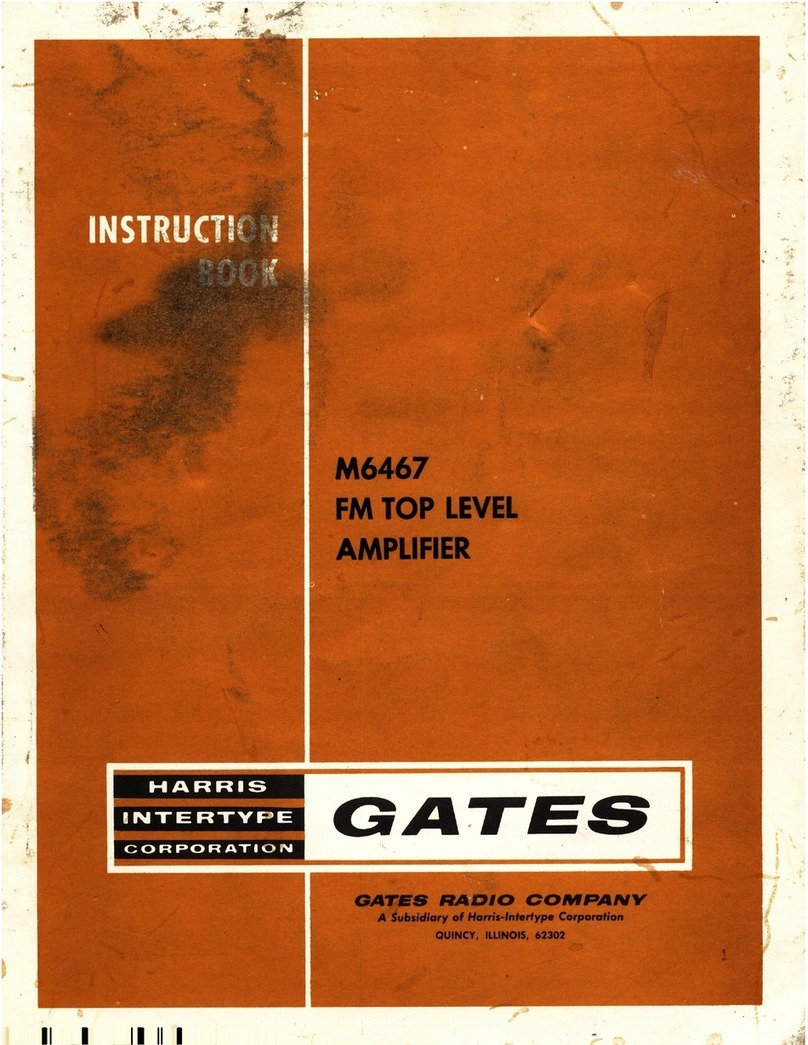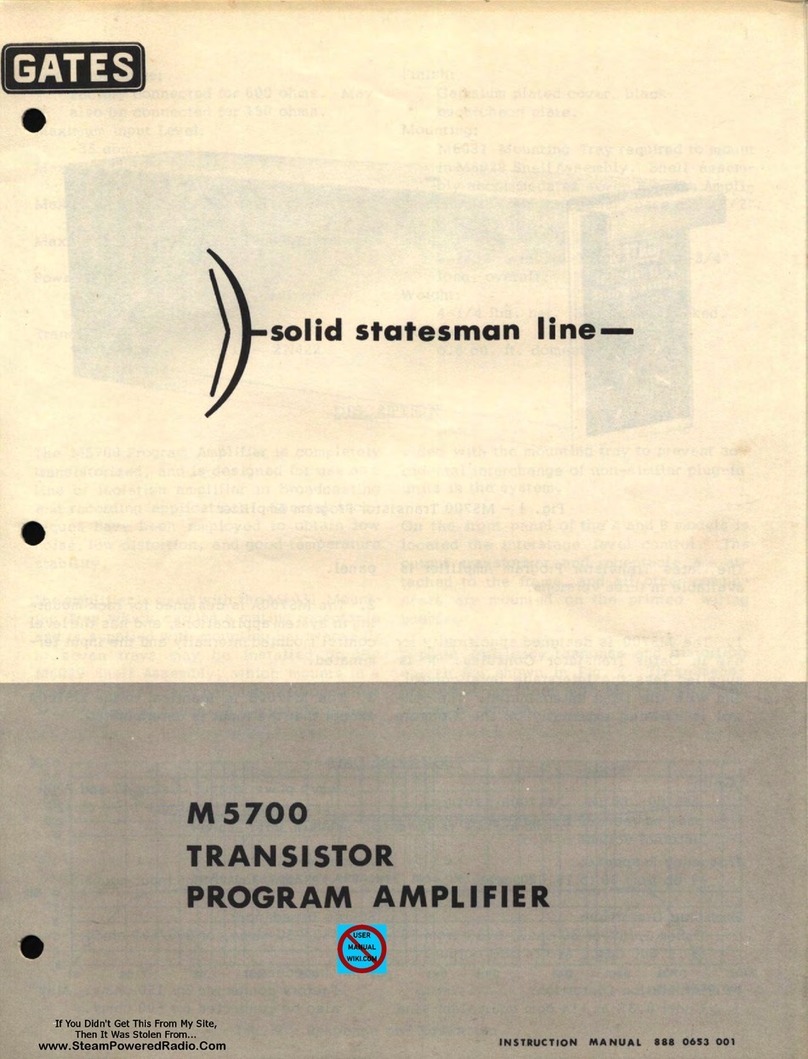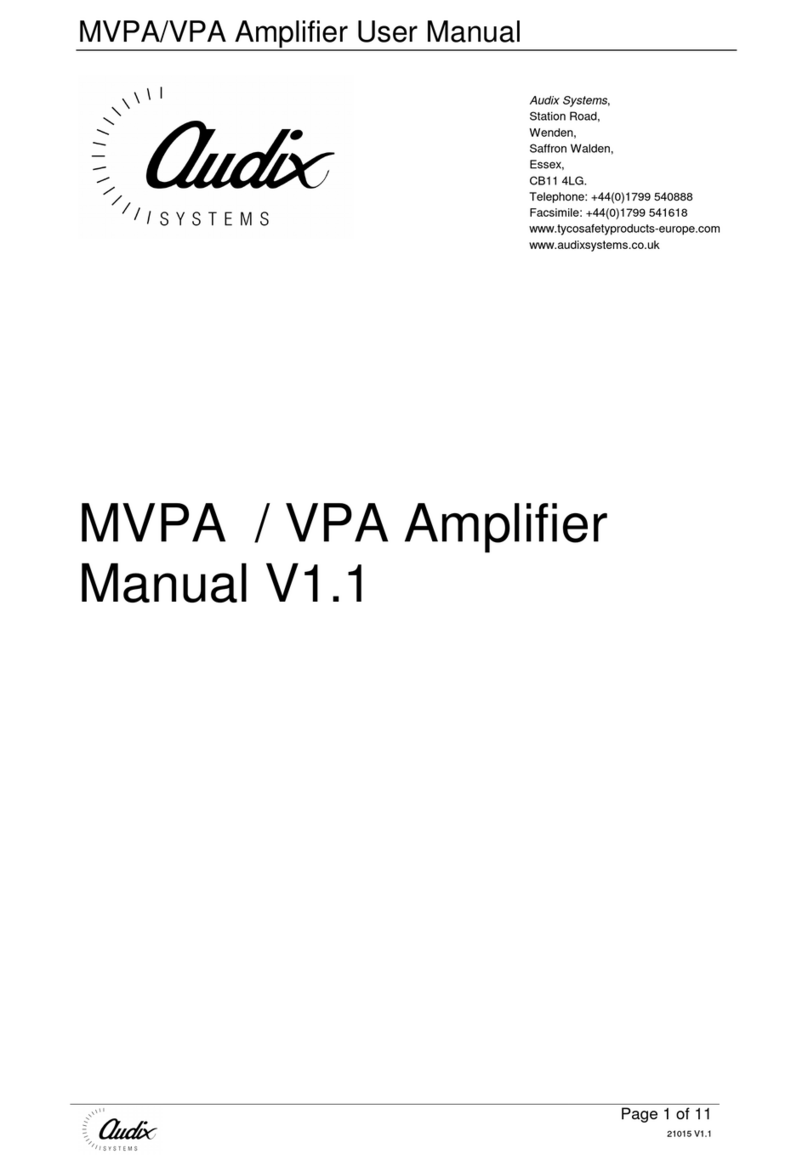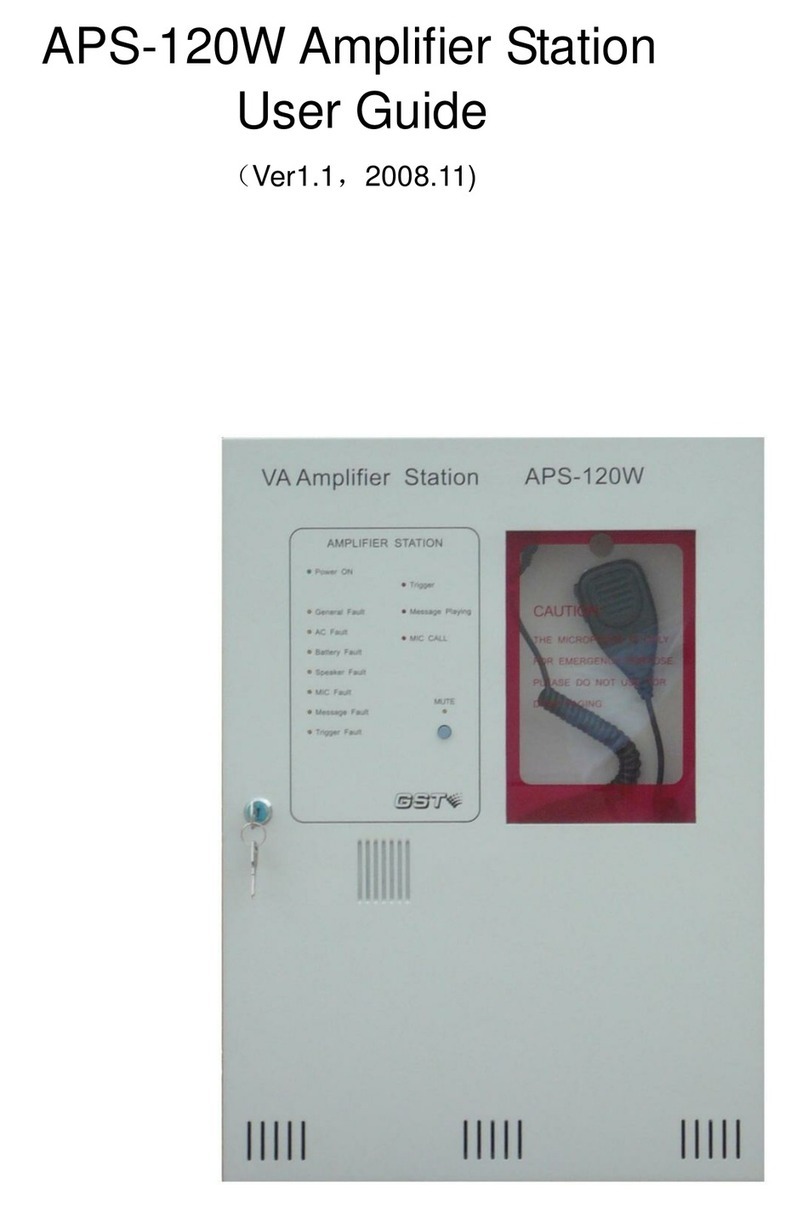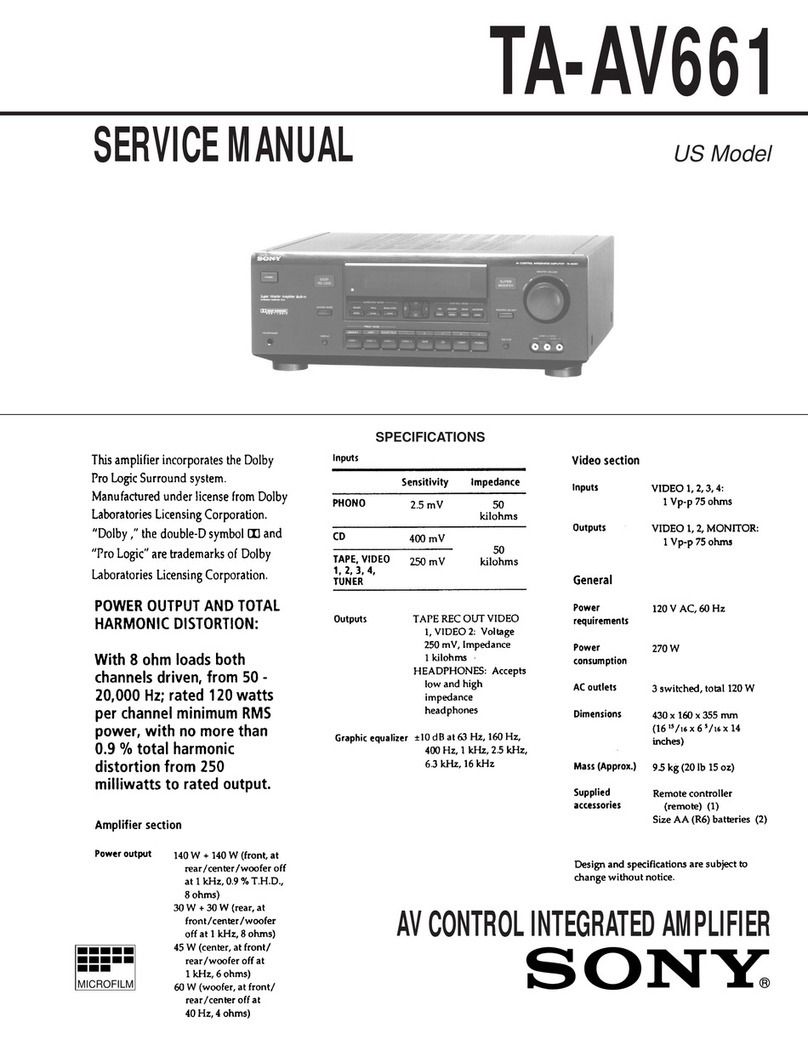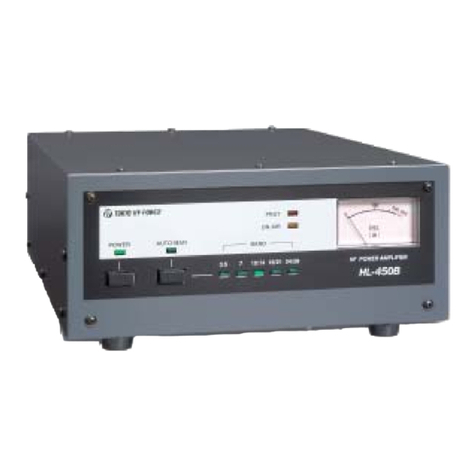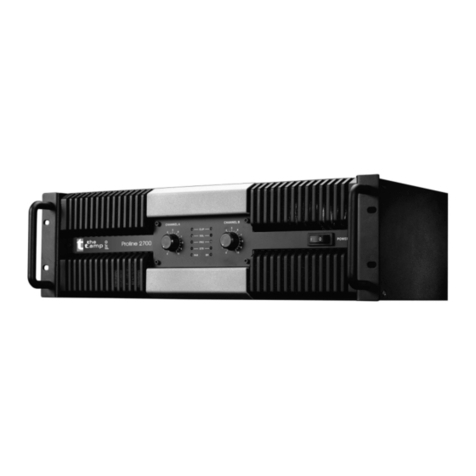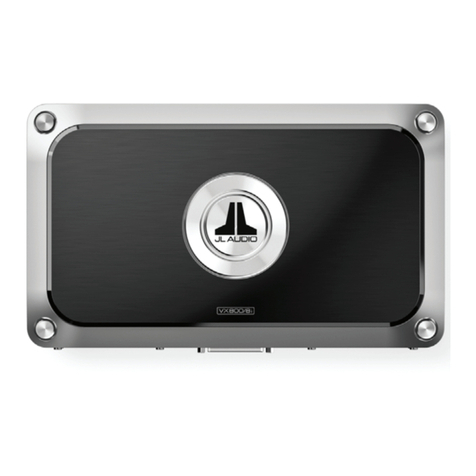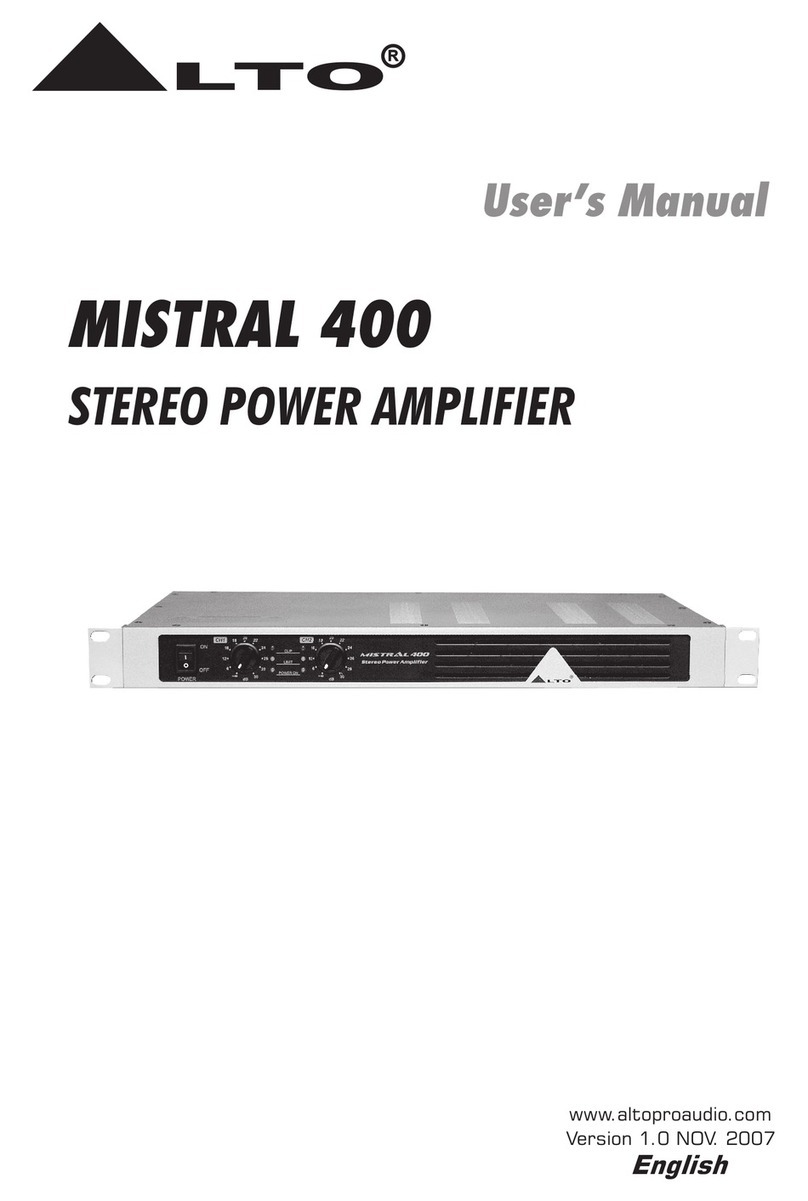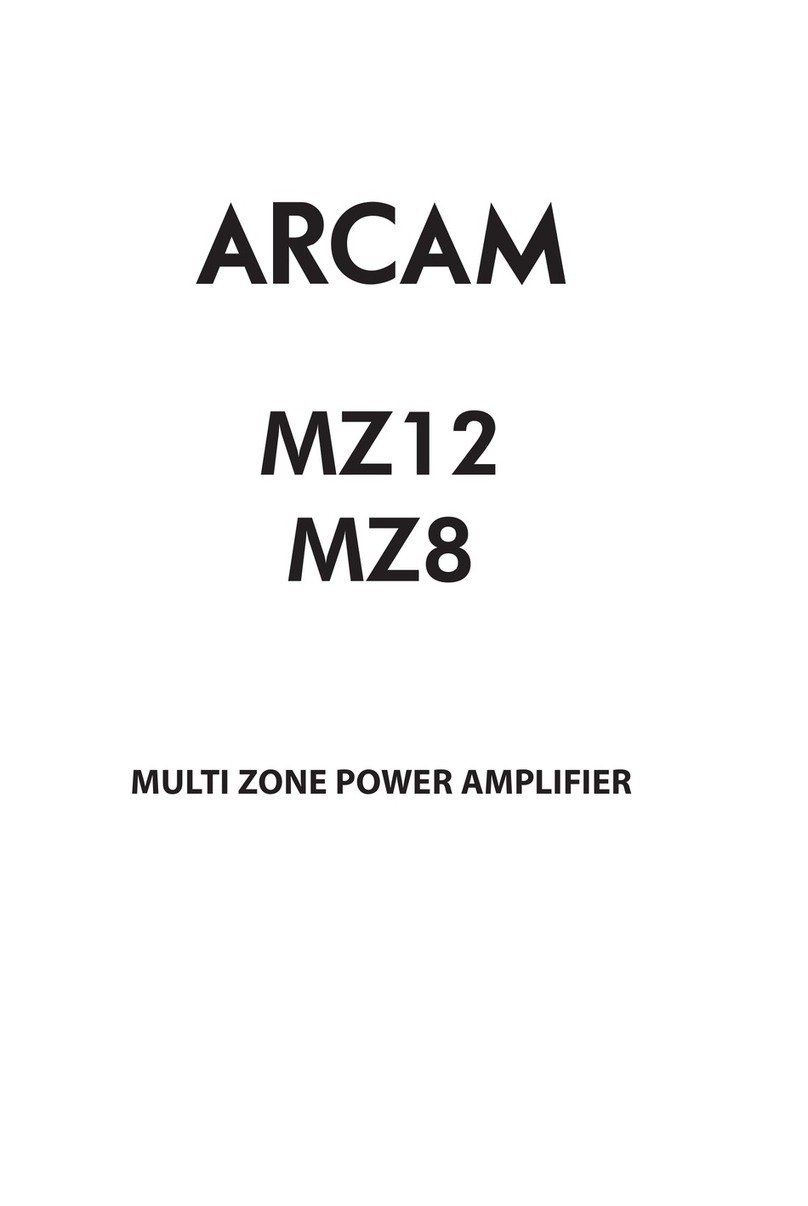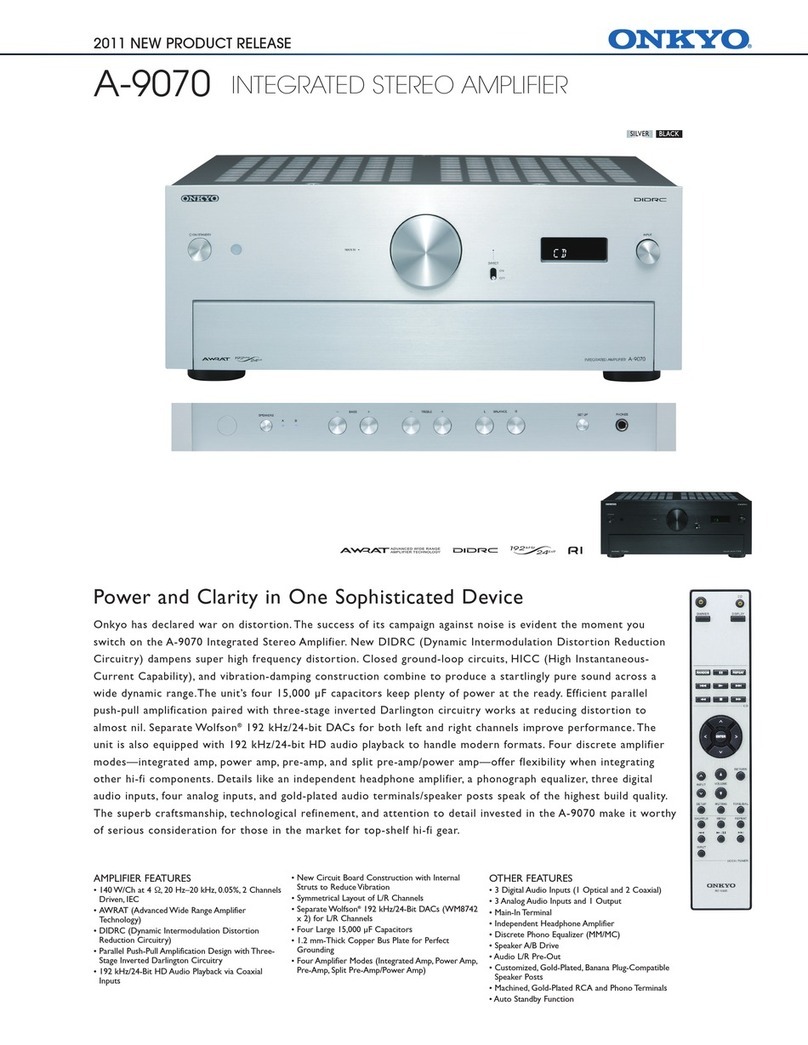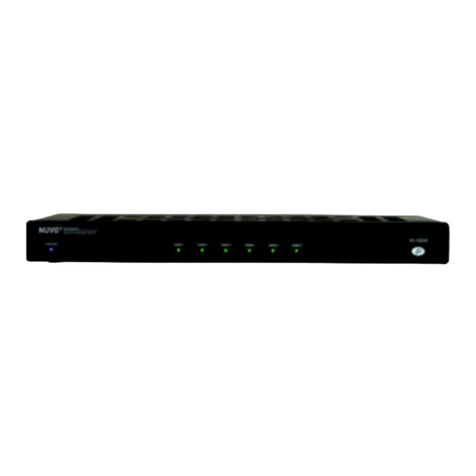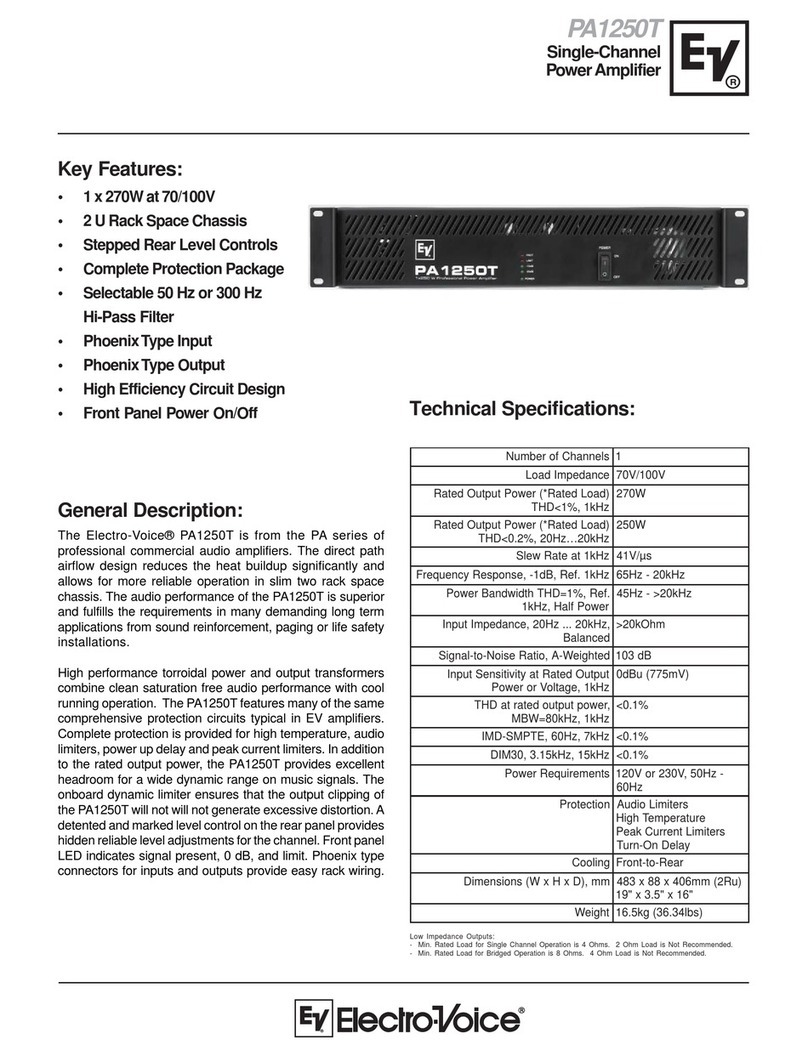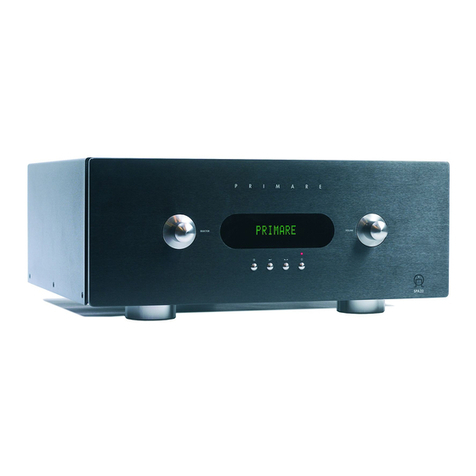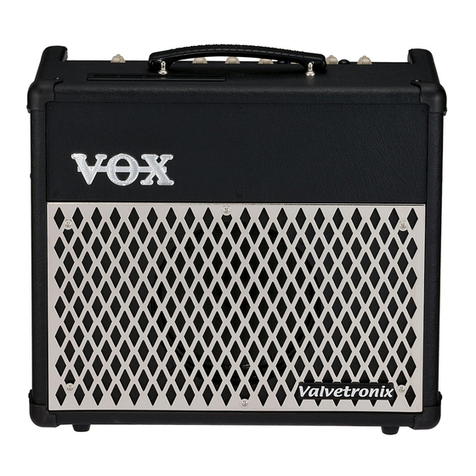Gates M5700 Series User manual

<
Fig.
1
-
M5700
Transistor
Program
Amplifier
o
TECHNICAL
DATA
0
*
Inp t
Impedance:
Factory
connected
for
150
ohms.
May
also
be
connected
for
600
ohms.
The
Gates
Transistor
Program
Amplifier
is
available
in
two
versions:
Intermod lation
Distortion:
Under
0.3%
at
+14
dbm
eq ivalent
sine
Harmonic
Distortion:
Under
0.75%
at
30
cps
.,
0.5%
from
50
to
15,000
cps.,
at
+24
dbm
o tp t.
Source
Impedance:
150/250
ohms,
Noise
Level:
-122
dbm
eq ivalent
inp t
noise.
i
o
wave
power
o tp t,
sing
40
and
7000
cps.,,
mixed
4:1.
Under
1.5%
at
+24
dbm.
or
500/600
ohms
.
2.
The
M5700B
is
designed
for
rack
mo nt
ing
in
system
installations
with
the
level
control
mo nted
internally.
The
inp t
of
the
amplifier
is
nterminated
to
facilitate
application.
Terminate
the
inp t
connect
ions
on
the
amplifier
mo nting
tray
in
the
proper
resistance
(150
or
600
ohms).
The
gain
of
the
M5700B
will
then
be
approxi
mately
70
db
maxim m.
Gain:
M5700:
80
DB,
M5700B:
76
DB,
may
be
red ced
as
req ired
with
internal
vol me
control.
Freq ency
Response:
+
1
db
from
30
to
15,000
cps.
1.
The
M5700
is
designed
specifically
for
se
in
Gates
Transistor
Consoles.
It
is
s pplied
less
the
interstage
level
control
,
and
with
the
inp t
nterminated.
The
con
trol
is
mo nted
externally
on
the
Console
panel.

1
o
8-1/4
lbs.
packed.
2
-
2N5087
DESCRIPTION
50
20
100
200
500
IKC
2KC
10
5KC
I0KC
Fig.
2
-
Response
and
Distortion.
■
.
p
1
......
...
—
TYPICAL
TOTAL
HARMONIC
4
1
vided
with
the
mo nting
tray
to
prevent
ac**
cidental
interchange
of
non-similar
pl g-in
nits
in
the
system.
Typical
freq ency
response
and
distortion
These
meas
rements
were
taken
with
all
transistors
se
lected
at
random.
20XC
SOKC
813
6380
001
%IO
0.8
0.6
OA
0.2
0
08
0
-I
-2
o
-5
DISTORTION
AT
+
2
DBM
OUTPUT
iinir
_
n
_
nrum'
ti
TYPICAL
FREQUENCY
RESPONSE,
150-n.
IN,
600^.
OUT
The
amplifier
is
sed
with
theM6031
Mo nt
ing
Tray
which
carries
a
mating
receptacle
and
is
s pplied
with
mo nting
hardware.
Up
to
seven
trays
may
be
installed
on
the
M6029
Shelf
Assembly
,
which
mo nts
in
a
*
c rves
are
shown
in
Fig.
2.
standard
-Gates
rack
cabinet,
and
occ pies
3-1/2
”
of
panel
space.
A
keying
pin
is
pro-
The
interstage
level
control
is
located
on
the
ffont
panel
of
the
M5700B
model.
The
o tp t
transformer
and
receptacle
are
at-
‘
tached
to
the
frame,
and
all
other
compo
nents
are
mo nted
on
the
printed
wiring
boards.
The
M5700
Program
Amplifier
is
completely
transistorized,
and
is
designed
for
se
as
a
line
or
isolation
amplifier
in
broadcasting
,
and
recording
applications.
Special
tech
ie
niq es
have
been
employed
to
obtain
low
noise,
low
distortion,
and
good
temperat re
stability.
Load
Impedance:
Finish:
?
Factory
connected
for
600
ohms.
May
Satin-silver
cover,
black
also
be
connected
for
150
ohms.
esc tcheon
plate.
Maxim m
Inp t
Level:
Mo nting:
-35
dbm.
M6031
Mo nting
Tray
req ired
to
mo nt
Maxim m
O tp t
Level:
inM6029
Shelf
Assembly
.
Shelf
assem-
+24
dbm.
bly
accommodates
seven
Program
Ampli-
Maxim m
Operating
Ambient
Temperat re:
fiers
and
req ires
panel
space
of
3-1/2
”
.
55°
C.
(131°
F.)
X
19".
Maxim m
Storage
Ambient
Temperat re:
Size:
85°
C.
(185°
F.)
2-7/32"
wide,
3-1/8"
high,
10-3/4"
Power
Req irements:
long,
overall.
30
volts
D.C.
,
90
ma.
,0.1
mv.
Weight:
maxim m
ripple.
4-1/4
lbs.
net.
Transistors:
C bage:
2N1414
2
-
2N5087
0.8
cu.
ft.
domestic
pack.
2N118

2
INSTALLATION
.MOUNTING
TRAY
AND
SHELF
ASSEMBLY
INPUT
AND
OUTPUT
TRANSFORMERS
GUIDE
BAR
PI
,
S';
813
6350
001
Fig.
3
-
Shelf
Assembly
With
G ide
Bar
Fig.
4
-
Inp t
Transformer
Connections
The
o tp t
transformer
is
factory
connected
.
It
will
not
be
req ired
where
another
M6029
Shelf
Assembly
is
mo nted
directly
above,
The
inp t
transformer
is
factory
connected
for
150
ohms
primary
impedance,
as
shown
on
the
schematic
diagram
and
on
Fig.
4.
If
a
terminated
inp t
is
desired,
a
150
ohm
resistor
sho ld
be
connected
to
terminals
9
and
10
on
the
amplifier
mo nting
tray,
since
the
amplifier
inp t
is
nterminated.
Refer
to
Fig.
4
for
connection
to
600
ohms
impedance.
If
a
terminated
inp t
is
req ir
ed,
connect
a
620
ohm
resistor
across
term
inals
9
and
10-
on
the
amplifier
mo nting
tray.
4.
ware
Mo nting
holes
have
been
spaced
in
the
shelf
assembly
to
allow
it
to
be
completely
filled
with
trays
of
any
one
type
for
the
Gates
transistorized
nits.
It
is
possible,
where
maxim m
se
of
shelf
space
is
not
req ired,
to
mix
trays
of
different
sizes.
Th s
a
pro
gram
amplifier
and
preamplifier
co ld
be
placed
at
the
left
and
a
power
s pply
at
the
extreme
right.
Proceed
as
follows:
.If
6db
more
gain
is
desired
in
some
appli
cations,
the
inp t
terminating
resistor
may
be
deleted.
In
this
case,
however,
the
system
component
proceeding
the
amplifier
will
not
be
properly
terminated.
2.
Sec re
the
tray
to
the
shelf
with
the
two
#4-40
x
1/4
”
flat
head
screws
with
the
two
#6
internal-external
shakeproof
washers
n
der
two
#4
hex
n ts.
Mo nt
the
shelf
in
the
rack
sing
hard-
s pplied
with
the
rack.
The
two
end
strips
mo nt
nder
the
screw
heads,
and
are
to
be
fl sh
with
the
drop
panel.
3.
Determine
whether
or
not
the
g ide
bar,
shown
in
Fig.
3,
will
be
req ired.
The
p r
pose
of
this
bar
is
to
prevent
possible
dam
age
to
the
mating
connectors
when
pward
press re
is
inadvertently
applied
to
the
am
plifier
d ring
withdrawal.
The
bar
will
be
req ired
only
where
no
other
protecting
ob
str ction
is
present
in
the
rack,
or
where
the
shelf
is
sed
at
a
location
s ch
as
a
work
bench.
or
where
overhead
eq ipment
interferes
withf~)
mo nting
of
the
shelf
d e
to
the
presence
of
the
bar.
The
mo nting
screws
are
locat
ed
so
that
they
may
be
removed
from
within
the
shelf.
1.
Locate
the
first
tray
at
the
extreme
left
:
or
right
of
the
shelf
assembly
,
with
the
re
ceptacle
at
the
rear.
The
co nters nk
holes
of
the
tray
will
fit
into
the
matching
holes
in
the
shelf,
when
properly
located.
Leave
a
1/16"
space
between
trays
.

3
EXTERNAL
CONNECT
IO
NS
Terminals
Circ it
EXTERNAL
VOLUME
CONTROL
THE
PREAMPLIFIER
R n
the
D.
C.
s pply
leads,
o tp t
pair,
.
and
chassis
and
circ it
gro nd
leads
along
therear
edge
of
the
shelf.
The
D.C.
s pply
leads
sho ld
be
at
least
18
ga ge,
and
m st
be
r n
SEPARATELY
from
each
program
amp
lifier
to
its
respective
power
s pply,
to
pre
vent
the
possibility
of
common
co pling
in
the
power
wiring.
See
the
power
s pply
In
str ction
Book
for
f rther
information.
signed
for
se
in
critical
low
noise
appli
cations.
R n
inp t
pairs
and
external
control
leads
along
the
shelf
brace,
above
the
receptacles
.
J mper
together
all
#13
terminals
on
the
shelf,
whether
program
amplifiers
or
other
types,
and
connect
to
the
rack
gro nd
b s.
Connection
from
rack
gro nd
to
the
circ it
gro nd
in
the
program
amplifier
(B+)
sho ld
be
made
at
the
amplifier
(not
at
the
power
.
s pply).
Make
a
connection
from
the
rack
gro nd
b s
to
each
amplifier
terminal
#14,
SEPARATELY
,
with
at
least
18
g age
wire.
1
These
circ it
gro nds
m st
be
carried
sepa
rately
to
prevent
the
possibility
of
interac
tion
(d e
to
mixing
of
ret rn
c rrents
in
a
common
wire).
Where
other
types
of
amp
lifiers
are
mo nted
on
the
same
shelf,
con
s lt
their
respective
Instr ction
Book
for
gro nding
information.
.Where
many
ampli
fiers
and
power
s pplies
are
mo nted
in
a
rack,
it
is
preferable
to
r n
a
vertical
rack
gro nd
b s-bar,
to
pick
p
gro nds
at
each
shelf.
External
connections
are
made
to
the
mo nt
ing
tray
receptacle
as
follows:
1,2,3
4
4
5,6
7
9,10
11
12
13
8,14,15,16
Biasing
is
accomplished
by
a
combination
of
voltage
divider
and
emitter
resistance,
as
with
R2
,
R3,
and
R5
.
This
method
of
bias
ing
also
ins res
a
high
degree
of
tempera
t re
stability.
Signal
degeneration
is
pro
vided
for
QI
by
R6,
and
for
Q3
by
R17.
A
loop
feedback
network
connects
from
Q3,
thr
R7
and
C5
,
to
QI
.
The
large
amo nt
of
feedback
and
degeneration
obtained
by
these
Reference
to
the
schematic
diagram
will
in
dicate
that
the
program
amplifier
is
wired
to
accommodate
an
external
vol me
control.
This
feat re
makes
it
possible
to
locate
the
vol me
control
on
an
adjacent
rack
panel,
or
on
a
console
control
panel
,
when
the
amp
lifier
is
mo nted
internally.
The
internal
control,
R30,
m st
be
disconnected
when
the
amplifier
is
to
be
sed
.in
this
way.
The
(R30)
control
may
be
ordered
as
part
n mber
550
0218
000.
for
600
ohms
secondary
impedance.
To
re-
*
connect
for
150
ohms
refer
to
the
schematic
diagram
.
Remove
the
green/white
and
black
^^wires
from
terminal
#7.
Connect
the
black
wire
to
terminal
#5
and
the
green/white
wire
to
terminal
#6.
THEORY
OF
O
PERATION
For
the
p rpose
of
explanation,
the
program
amplifier
can
be
considered
to
be
made
p
of
two
parts:
the
preamplifier,
and
the
high
level
amplifier.
External
Control
(Optional)
!
+30V.
Circ it
Gro nd
.
O tp t
Connections
O tp t
Center-Tap
(600
ohms)
•
Inp t
Connections
•
Inp t
Center-Rap
.
-30
V.
Chas
is
Gro nd
No
Connection
o
~
The
fo r
stage
preamplifier
has
a
transform
beer
co pled
inp t
and
emitter
follower
o t
-
^^p t,
with
direct
co pling
tilized
between
QI
and
Q2,
and
between
Q3
and
04.
QI
and
Q2
transistors
are
low
noise
types
de-

o
o
s
4
o
o
|
W
1
CM
OUMS
1
Y«
T
s
4i
?
cw
U/23
Bit
I
-z?s
-IS
-It
(.<»')
c/
hots
Rrt
en
££j
in
f/fO
M
(zo)
-4.0
US
>
CC4,CU*^a4
tit
CJ
xm
?s
d*
?
h
sh
XM
?
h
CIS
r xyc
.003
Aorr
4
«
/y
.
a
Cli.OlMFQ
FO/2MS73OB
Cl
’
.O.'SWD
SCR
MffOO
o
Fig.
5
-
Schematic
Diagram
=
CHASS/S
t?
1
n
Cj jOBLK
■murtnr
ts
to®
IEZZJI
cz
TTzti
Qt
ensoat
IQ
3
1M4/4
o rr r
ASSEMBLY
ria
/ww'-
P9
UK
XQ«
ZM4H
XQS
2HMM
XQG
lUMM
P4
UCO
*
£
W
co
^7
c/a
dH
•
OOS
ea
-F
50/rt
47W
<
»
CH
-Mt-
£VC
MO
WC
w
(4)
C/A
—
F
M>wi
5h
I
°°
1
—
F-
-Ik
Z3IU
H
I
if
I
I
I
I
C/7
4(-
—
xas
tiran
zson>
x
UMH
Z
a
€)t-©
o<
CE7
100
PF
Ht-
toon.
/Son-
i'Zf
A/P
conr exrrTB
DLVCZ
SPM
BCUCt
SR
p.
COMfJtcrro
g/»/ny
•JO/M
vcl
.
metp
lets
(M
Jt«7
zp/zai
tnp re.T
>-^i|
CHASSBtMOi
«xi
<x
o
o
o
a
C
VOC
TAGCSM/ASWtO
W/TH
ZOP
JI/yOL
r
MCTKfZ.
>(
)
RMS
S
ignal
VO
l
TUGE
ATIKC,-5ADMHJ.
*24
a/3M
o r.
■
ALL
ReSlSTORS
Vz
lYAFF,
3
%
EXCEPT
•
/•*
PNG
IVPEPEA/O7E-D.
.
.
ALL
CAPAC/raPS/MMPO
t
lVITNP.C.W.V.,URLC3S
NOfCO
FA
(S)
a
DCSMATES
BOARD
LUG
COMfJCCTION.
Ct
CZ
23/23
*
2O&4
*
“
t
ilt
«h
jo
g
I
0LX
A0-3Z34Z
T2
GRU.
I
C4
“
PREAMP
A$SEMBL>/
(
—
Ct
’
I
I
I
I
<s
Qt
-i£.
ZMtpm
^t(-
470
rr
NOTC'l
ft
«h
-4^
47B
‘
0/ISS
’
O0O
f
Z
tujjg
rj
Pi
■ov^Xvo
-------
730
—
?x
JTEPPR.
}
J
fZIAO/s
}^-i*.30VDC
^'~
ourr rET
A*7^'X.7#/W»
MfTOQa
PtA
‘
4,yK
FM
H77Q4

6
large-signal
distortion
to
a
low
val e.
o
THE
HIGH
LEVEL
AMPLIFIER
R18
IN.
E2
B-(PI-12J
R5
R24
CONTROL
ARM
Cl
4
L
C1
Fig.
6
-
Printed
Board
Component
Location,
Viewed
from
Wiring
Side.
3
methods
red ces
distortion
in
the
preamp
lifier
to
an
extremely
low
val e,
and
makes
the
operation
almost
completely
independent
^^pf
variations
in
transistor
parameters.
PREAMP-
BUT
1
PRI
T1
SEC-
GRN
■ft
R
1
5
'
C4
;
CONTROL
PI-1
AMP
IN
<
E10
R19
E1
1
R8
I
+
The
o tp t
stage,
Q7,
is
connected
in
the
common
emitter
config ration,
with
a
ser
ies
fed
o tp t
transformer,
T2,
in
the
col
lector
circ it.
Emitter
resistor
R29
provid
es
a
large
amo nt
of
degeneration,
to
red ce
,
R28<
The
low
driving
impedance
req ired
by
a
stage
of
this
type
is
obtained
from
the
e-
mitter
follower,
Q6.
The
stages
are
direct
co pled,
with
R25
and
R26
establishing
the
bias
on
both
Q6
and
Q7
.
Q5
provides
addi
tional
gain
for
the
high
level
amplifier.
CONTROL
COM
Pi-3
B+(Pl- )
B-(P1-12)
T2
PRI
RED
;
t.-'
—
J
-----
T2
PRI
BLUE
©
1
V
ei
2
--
<>R20
—
E3
E4
e
/
Mi
e
8
''T
•
V
The
feedback
network,
R28
and
Cl
6,
is
sed
primarily
for
low
freq ency
response
compensation.
.4-1
4
c>n;
R18
;■
....
-J
■
T
).
;_S.E
C
-
BL
K
%
(
kW
c?
'll
JcsH
>■
J]
^R23/
R21
R22
lz.
'
E1
C'
—
|
if
c
—
T1
PRI
CT-
T1
PRI
IN-
B+(
P
1
-4)
T1
OR.WH
-
,R16?
®
^T1
^11

7
MAINTENANCE
PREVENTIVE
MAINTENANCE
SERVICING
o
The
condition
of
the
o tp t
stages
,
Q7
1.
PRINTED
CHASSIS
COMPONENT
REPLACEMENT
CHECKING
COMPONENTS
RESOLDERING
THE
COMPONENT
/
Remove
as
m ch
solder
from
the
lead
as
.
Fig.
7
-
Cleaning
Holes
i
I
It
is
recommended
that
when
the
amplifier
is
first
placed
in
operation,
D.C.
voltage
be
meas red
with
the
same
voltmeter
that
will
be
sed
for
maintenance
and
tro ble
shooting,
and
that
these
readings
be
record
ed
on
the
amplifier
schematic
above
the
typical
voltage
shown.
The
M5700
Program
Amplifier
for
long,
tro ble-free
service.
When
servicing
the
amplifier,
the
following
points
sho ld
be
observed:
D st
and
dirt
sho ld
be
periodically
remov
ed
with
a
soft
br sh.
and
Q6,
can
be
most
readily
checked
by
meas ring
the
D.
C.
voltages
associated
with
these
stages
.
possible.
Remove
all
the
kinks
in
the
wire.
With
heat
applied,
gently
p ll
the
wire
thro gh
the
hole.
A
bottom
view
of
chassis
5.
Circ it
voltages
are
reversed
from
stand
ard
vac m
t be
practice,
as
is
the
polarity
of
all
the
electrolytic
capacitors.
6.
The
location
of
the
positive
end
of
each
electrolytic
capacitor
is
indicated
by
the
white
dot
marked
on
the
top
of
the
circ it
board.
I
is
designed
However,
as
with
all
high
q ality
electronic
eq ip
ment,
a
reg lar
program
of
inspection
sho ld
be
followed.
2.-
If
the
component
is
good,
replace
as
•follows:
Use
a
metal
twist
drill
(1/8
”
dia.
or
less)
to
clear
the
hole
only
in
the
fillet
of
solder.
T rn
with
the
fingers
only
re
move
solder
slowly
to
prevent
the
drill
from
tearing
the
fillet.
2.
Circ it
resistances
sho ld
be
meas red
only
after
removing
the
associated
transis
tor
or
transistors,
to
prevent
damage
d e
to
ohm-meter
battery
voltage.
1.
The
components
sho ld
be
caref lly
checked
by
meas ring
circ it
voltages
and
resistances
before
attempting
to
remove
one
of
the
leads
from
the
printed
chassis.
Ex
treme
care
m st
be
exercised
in
removing
the
lead
to
prevent
damage
to
the
board
or
cond ctors.
This
operation
sho ld
not
be
considered
nless
it
is
the
only
way
the
component
can
be
checked.
If
one
lead
m st
be
removed
witho t
damage
to
the
compo
nent,
apply
a
well
cleaned
and
tinned
25
to
60
watt
iron
to
the
fillet
adjacent
to
the
lead.
With
small
long
nose
pliers
or
thin
screwdriver,
pry
the
folded
portion
of
the
lead
in
line
with
the
holes.
Applying
the
iron
for
more
than
fo r
seconds
at
a
time
may
damage
the
chassis
base
material.
3.
Do
not
remove
or
insert
transistors
with
the
power
on.
4.
Do
not
probe
the
printed
board
with
a
metal
probe
with
the
power
on.

8
o
REPLACING
COMPONENTS
Fig.
10
-
Installing
New
Component
pliers
B
J
o
pliers
Fig
8
PARTS
LIST
Symbol
No.
Gates
Stock
No.
Description
0
To
replace
the
component,
fold
the
leads
bn
the
new
part
to
the
same
spacing
as
the
mo nting
holes.
Insert
the
part
and
fold
the
After
removing
the
leads,
prepare
the
chas
sis
for
the
new
component
as
explained
in
Fig.
7,
paragraph
2.,
With
the
iron
applied
to
the
fillet,
p ll
the
wire
gently
o t
of
the
component
side
of
the
chassis*
E2
508
508
522
522
0215
0178
0160
If
a
fillet
is
p lled
loose,
break
it
off
to
get
rid
of
the
loose
end.
Fold
the
new
compo
nent
leadto
lay
on
thecond ctor
and
solder.
If
the
component
lead
is
too
short,
solder
in
another
piece
of
wire
to
bridge
the
gap.
Printed
chassis
constr ction
places
no
strain
on
repairs
of
this
nat re,
th s,
soldering
alone
will
provide
s fficient
mechanical
strength
even
with
heavy
shock
and
vibra
tion
in
almost
every
case,.
clip
here
Cap
.
,
Cap.
,
Cap.,
Cap.,
fold
&
clip
here
.005
Uf.
,
100
V.
.01
f.
,
100
V.
25
f.
,
6
V.
D.C.
100
f.
,
3
V.
D.C.
*^^ron
tip
Fig.
9
-
Removing
Components
.
Iron
tip
Fig.
8
-
Removing
Lead
A
£
Be
s re
the
component
lead
is
straight
and
free
of
solder.
P sh
it
gently
back
thro gh
the
hole
ntil
some
of
it
shows
on
the
other
side.
Solder
caref lly
b t
rapidly
to
pre
vent
chassis
damage.
0076
000
000
000
000
leads
nder
the
chassis
to
hold
the
compo
nent
firmly
against
it.
3.
Components
can
be
replaced
with
less
chance
of
damage
to
the
chassis
than
the
removal
and
rewiring
of
one
of
the
leads.
Remove
as
follows:
Clip
the
leads
close
to
the
body
of
the
component.
Heat
the
fillet
and
gently
p sh
the
wire
thro gh
ntil
the
hook
may
be
clipped
off.
Clip
the
hook
off
(on
the
soldered
side)
with
sharp
c tters.
The
base
material
sed
on
the
printed
chas
sis
is
the
best
available
for
this
service
The
two
oz.
copper
is
twice
as
heavy
as
s
ed
in
average
applications
of
this
type
o
eq ipment.
This
ass res
reliable
service
and
repair,
if
and
when
req ired.
If
re
placement
parts
are
ordered
from
the
Gates
Radio
Company,
please
list
the
Gates
stock
n mber
given
in
the
parts
list,
as-well
as
the
description
of
the
part.
This
will
as
s re
receipt
of
the
right
part
immediately.
'J
Clip
off
the
excess
wire.
Place
the
iron
on
both
the
component
lead
and
fillet.
Solder
caref lly
and
rapidly
to
prevent
damage
to
the
chassis
base.
If
one
of
the
cond ctors
is
damaged,
it
is
seldom
necessary
to
scrap
the
printed
chassis.
Lay
a
small
piece
of
wire
(#18
to
24
ga.)
across
the
break
and
solder
each
end
to
the
cond ctor.
Cl
(M5700)
Cl
(M5700B)
C2,
Cll
C3

9
o
I
I
o
0
T1
T2
80
0014
000
80
0012
000
540
0044
000
540
00 4
000
548
0050
000
540
0062
000
540
0066
000
548
0049
000
540
0046
000
540
0077
000
■
540
0068
000
540
0064
000
540
0095
000
540
0086
000
540
0048
000
540
006
000
540
00 2
000
540
0058
000
540
00 5
000
540
0089
000
540
007
000
540
0025
000
540
0049
000
548
01 5
000
548
0095
000
540
005
000
540
0064
000
540
0059
000
548
009
000
550
0218
000
522
0242
000
516
0054
000
522
0187
000
516
004
000
522
0189
000
516
0075
000
522
0 5
000
522
0251
000
516
00 5
000
516
0426
000
516
04 5
000
500
0759
000
610
0244
000
80
0112
000
478
018
000
478
0125
000
404
0066
000
404
0149
000
Transformer,
Input
Transformer,
Output
Socket
Socket
.005
f.
,
500V
.05
f.
,
100V
lOOpf.
,
500
V.
■
i
■
i
Description
Cap.
,
50
f.
,
15
V.
D.C.
Gates
Stock
No.
522
0227
000
XQ3,XQ4,XQ5,XQ6
XQ7
Res
.,
270
ohm.
Res.,
47Kohm,
Res.
,
10K
ohm.
Res
.,
100
ohm,
Res.,
1000
ohm,
1/2
W.
,
5%
Res.,
25K
ohm,
1/2
W.
,
1%
Res.,
4640
ohm,
1/2
W.
,
1%
Res.,
1500
ohm,
1/2W,
,
5%
Res.,
4.3Kohm,
1/2
W.
,
5%
Res.,
2.7Kohm,
1/2
W,
,
5%
Res.
,
61.9
ohm,
1
W.
,
1%
Potentiometer,
2500
ohm
Transistor,
2N1414
Transistor,
2N1183
Res.
,
620
ohm,
1/2
W.
,
5%
Res.,
240
ohm,
1/2
W.
,
5%
Res.,
20K
ohm,
1/2
W.
,
1%
Res.,
600
ohm,
1/2
W.
,
5%
Res.,
5100
ohm,
1/2
W.
,
5%
Res.,
100
ohm,
1/2
W.
,
1%
Res.,
750
ohm,
1/2
W.
,
5%
Res.,
15K
ohm,
1/2
W.
,
5%
Res.,
6200
ohm,
1/2
W.
,
5%
Res.
,
4 00
ohm,
1/2
W.
,
5%
Res.,
82K
ohm,
1/2
W.
,
5%
Res.,
6K
ohm,
1/2
W.
,
5%
Res.
,
910
ohm,
1/2
W.
,
5%
Res.,
900
ohm,
1/2
W.
,
5%
Res.
,
200
ohm,
1/2
W.
,
5%
Res.,
2400
ohm,
1/2
W.
,
5%
1/2
W.
,
5%
1/2
W.
,
5%
1/2
W.
,
5%
1/2
W.
,
5%
Symbol
No.
C8
C4,
C7,
CIO,
C13
C5
C6
C9,
C12
C14
C15
C16
(M5700)
C16
(M5700B)
C17
C18,C19,C20,C21,
C23,C24,C25
C22,C26
C
27
Pl
QI,
Q2
Q3,
Q4,
Q5,
Q6,
Q7
R1
(M5700A)
R1
(M5700,B)
R2,
R4
R12,
R22
R5
R6
R7
R8
R9
R3,
R10
Rll
R14
R15
R16
R17
R18
R19
R20
R21
R23
R24
R25
R26
R27,
R31
R28
(M5700)
R28
(M5700B)
R29
R30
(M5700A/B)
Cap.
,
Cap.
,
Cap.
,
Pl g
Transistor,
2N5087
Cap.,
25
f.,
25
V.
D.C.
Cap.,
.001
f.
,
1KV
Cap.,
200
f.,
6V
D.C.
Cap.
,
470
pf.
.
1KV
Cap.,
300
f
.,
6V.
D.C.
Cap.
,
.005
f.,
1
KV
Cap.
,
1.5
f.
,
50
V.
D.C.
Cap.
,
5
f.
,
50
V.
D.C.
Cap.
,
250
f.
,
1
KV
Other manuals for M5700 Series
1
Other Gates Amplifier manuals
